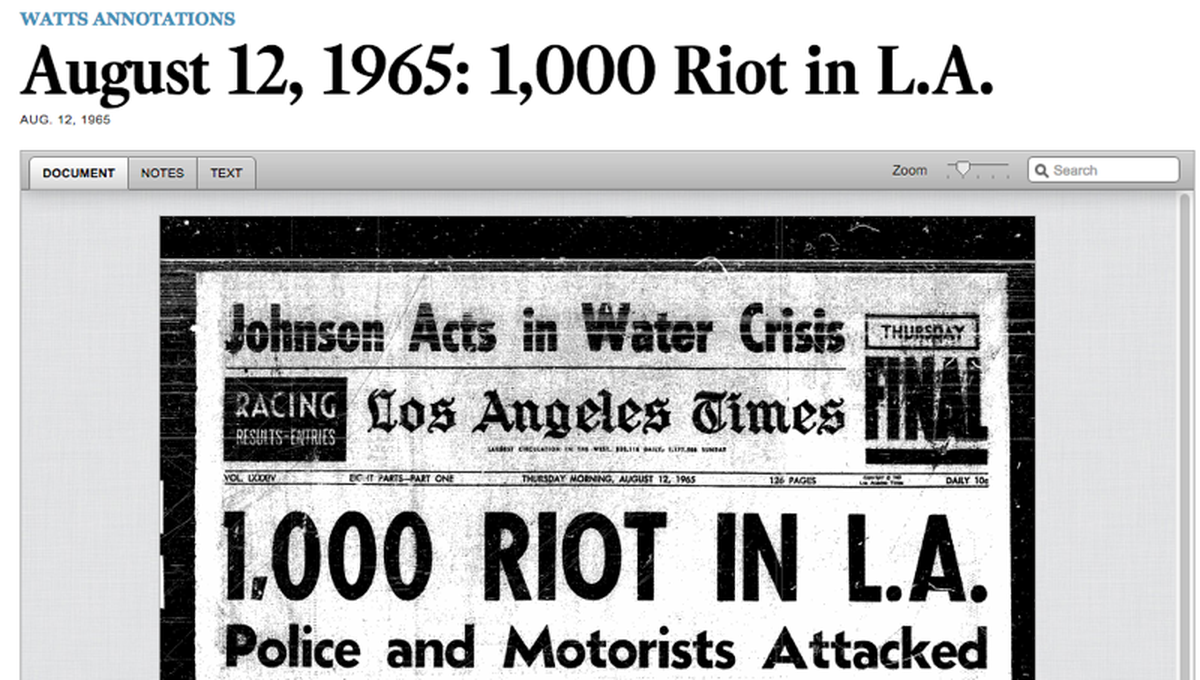Features:
News Nerd Roundup, Aug 21
Newsroom code and projects that caught our eyes

The Los Angeles Times presents annotated archives and reflections on its coverage of Watts in 1965.
Here’s a recent roundup of what we’ve been reading, what inspires us, and what we’re fascinated by, from the last week or two.
Stunned by the Watts riots, the Los Angeles Times struggled to make sense of the violence
Los Angeles Times (August 12, 2015)
In 1965, the Los Angeles Times covered Watts with many missteps and few big milestones. Annotations link directly to the paper’s archives and act as a reckoning over the damage that ink can do. Part of the series, Watts Riots Remembered.

Draw Where You Think Your Neighborhood Borders Are on This Map
DNAinfo - New York (August 11, 2015) and DNAinfo - Chicago (August 12, 2015)
For this mapping project, borders are in the eye of the beholder. After a user draws lines around her (perceived) neighborhood, the app shows how others drew the same border. The result is a lovely, mis-aligned overlay showing how we always live on disputed ground. Here’s the version for Chicago.
Post-Katrina New Orleans Smaller, But Population Growth Rates Back On Track
NPR (August 19, 2015)
A forever-changed New Orleans marks ten years after Hurricane Katrina, but some population trends have shifted back to pre-storm patterns. These charts peel back layers of change, supported by context on what the numbers do (and don’t) tell us.

Left Behind
The Post and Courier (August 18, 2015)
This series on the charter school movement lives on an innovative story platform and buoys heavy data with first-person storytelling. We also appreciate how UX intertwines with data interpretation here, through the super clear explainer of a data visualization.
Inside Amazon
The New York Times (August 16, 2015)
A time-lapse video illustrates the crux of the story, and portraits with pull quotes punctuate heavy-duty reporting with faces and voices.
There were responses a-plenty to the story, including this on Signal v. Noise from Basecamp’s David Heinemeier Hansson, a reminder for all organizations that talk about workplace culture:
“…The bottom line is that culture is what culture does. Culture isn’t what you intend it to be. It’s not what you hope or aspire for it to be. It’s what you do.”
Meanwhile, not so far from Seattle, the land is burning. Here’s an interactive map from the Seattle Times (August 20, 2015), based on data from the U.S. Geological Survey.
The Ketamine Cure
Bloomberg Business (August 19, 2015)
Scroll, scroll, scroll through this look at ketamine and major depression. Scroll events embody the shifting and often-mysterious interactions between brain chemistry and man-made drugs.
But illustrating mental health doesn’t require tons of code. Sometimes you just need balloons and a Sharpie.

Wonderful Miscellany
If you never read the comments, here’s one alternative. And over at Colossal, black-and-white photos find wonderful new life.
Credits
-
 Lindsay Muscato
Lindsay Muscato
Editor of Source from 2015-2020



